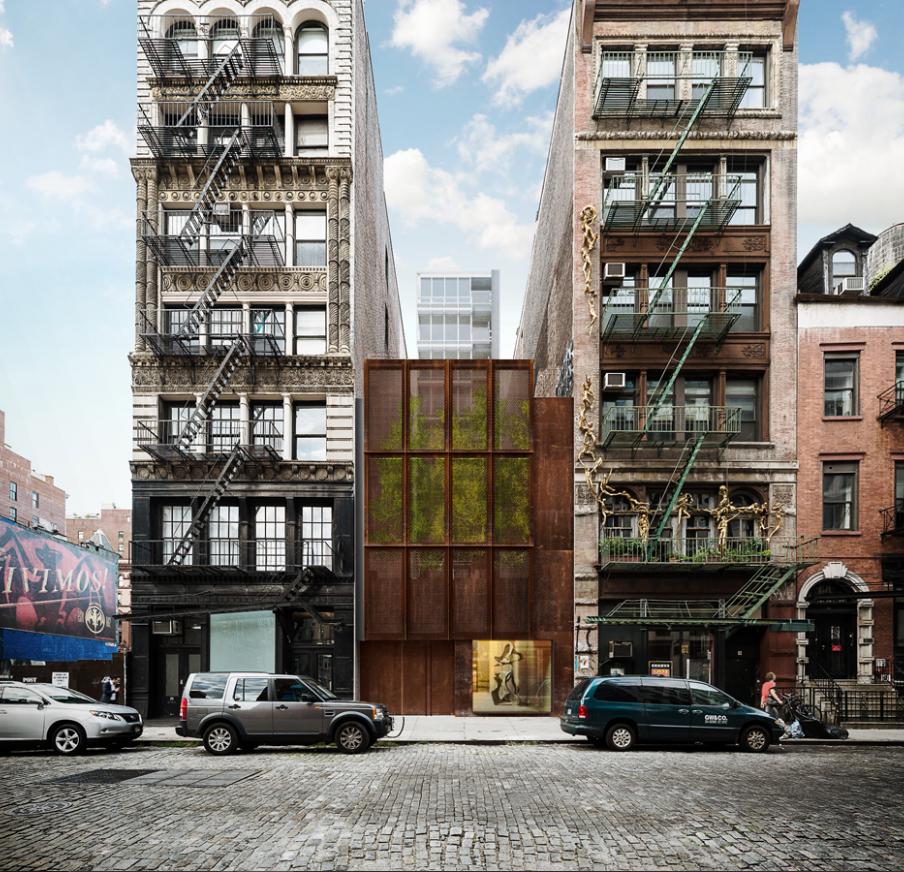
Rendering of façade facing Bond Street for through-block lot at 25 Great Jones Street, Manhattan. Image Credit: BKSK Architects.
New design would alter massing to use property for residential use instead of a hotel. On November 19, 2013, the Landmarks Preservation Commission held a hearing on a new proposal for a through-block lot at 25 Great Jones Street in the NoHo Historic District Extension, with the other façade facing Bond Street. The lot is currently occupied by a partially constructed thirteen-story structure that was permitted before the designation process for the extension began. Landmarks approved an application in March 2010 for the completion of the exterior of the buildings, gates, and courtyards by architect Henry Smith-Miller.
At the November 19th hearing, architect Harry Kendall of BKSK Architects stated that this new plan with a different massing from the approved project was a result of a determination by the property owners that the site was better suited for a residential building rather than a hotel. The building would be lowered by 31 feet, and the floor area would be reallocated to the building’s street wall on Great Jones Street. Kendall said the massing changes were largely driven by directives from the Board of Standards and Appeals, from whom the owners will require a use variance. Kendall said residential use of the building was generally preferred to hotel use in the community.
On Great Jones Street, the building would have a seven-story streetwall, with three additional set back stories. The building would have a façade depth of 18 inches, composed of Cor-ten steel fins in front of glass, with painted metal spandrels. Kendall said the Cor-ten would speak to the neighborhood’s “gritty” character and industrial past, while using a contemporary material. A mechanical penthouse on the building’s roof, clad in zinc, would be visible from some public thoroughfares.
On Bond Street, a one-story structure will connect to the main building and serve as a lobby. The Bond Street structure would be somewhat obscured by a three-and-half foot screen at the sidewalk, partially composed of Cor-ten. The structure will also have plantings on its roof. The gate and the plantings were inspired by the “deep history of Bond Street as a tree-lined townhouse-scale-street.” The main, ten-story structure would be faced with glass on the Bond Street side, but deeply set back from the street.
A mural by artist Jose Parla would cover almost all of the building’s west sidewall, which faces Lafayette Street. Kendall said that exposed sidewalls in the neighborhood had historically often been used for painted advertisements. Kendall also noted the served as a bohemian enclave home to many prominent artists like Chuck Close, Robert Mapplethorpe, and Keith Haring in the 20th century. The building is adjoined by an undeveloped corner lot, which if built up, would partially cover the mural, but would “leave a strong piece remaining” and “stay in the public realm.”
The proposal was welcomed by the Historic Districts Council’s Nadezhda Williams, who had opposed the 2010-approved plan, as a “modern, but neighborly, addition to the block.” A representative of the Greenwich Village Society for Historic Preservation also testified in support, commending the reduction in height from the previously-approved plan. Landmarks Chair Robert B. Tierney stated that Manhattan Community Board 2 had issued a recommendation that opposed the design of the Bond Street screen as “out of harmony” and the ratio of glass to solid on the Great Jones Street façade as excessive.
Commissioner Christopher Moore found the proposal appropriate, stating that the design was historic, intelligent, and artistic. Commissioner Margery Perlmutter said the site was currently a “blight” in the historic district that the “beautiful project” would rectify. Commissioner Perlmutter also praised the use of Cor-ten as a contemporary reference to cast iron. Commissioner Joan Gerner found the changes in the project’s massing would make a positive difference. Commissioners unanimously voted to issue a certificate of appropriateness for the project.
LPC: 22 Bond Street, Manhattan (14-9004) (Nov. 19, 2013) (Architect: BKSK Architects).
By: Jesse Denno (Jesse is a full-time staff writer at the Center for NYC Law)

